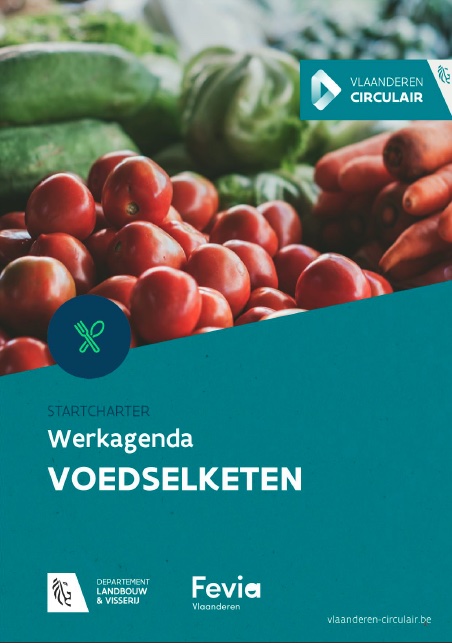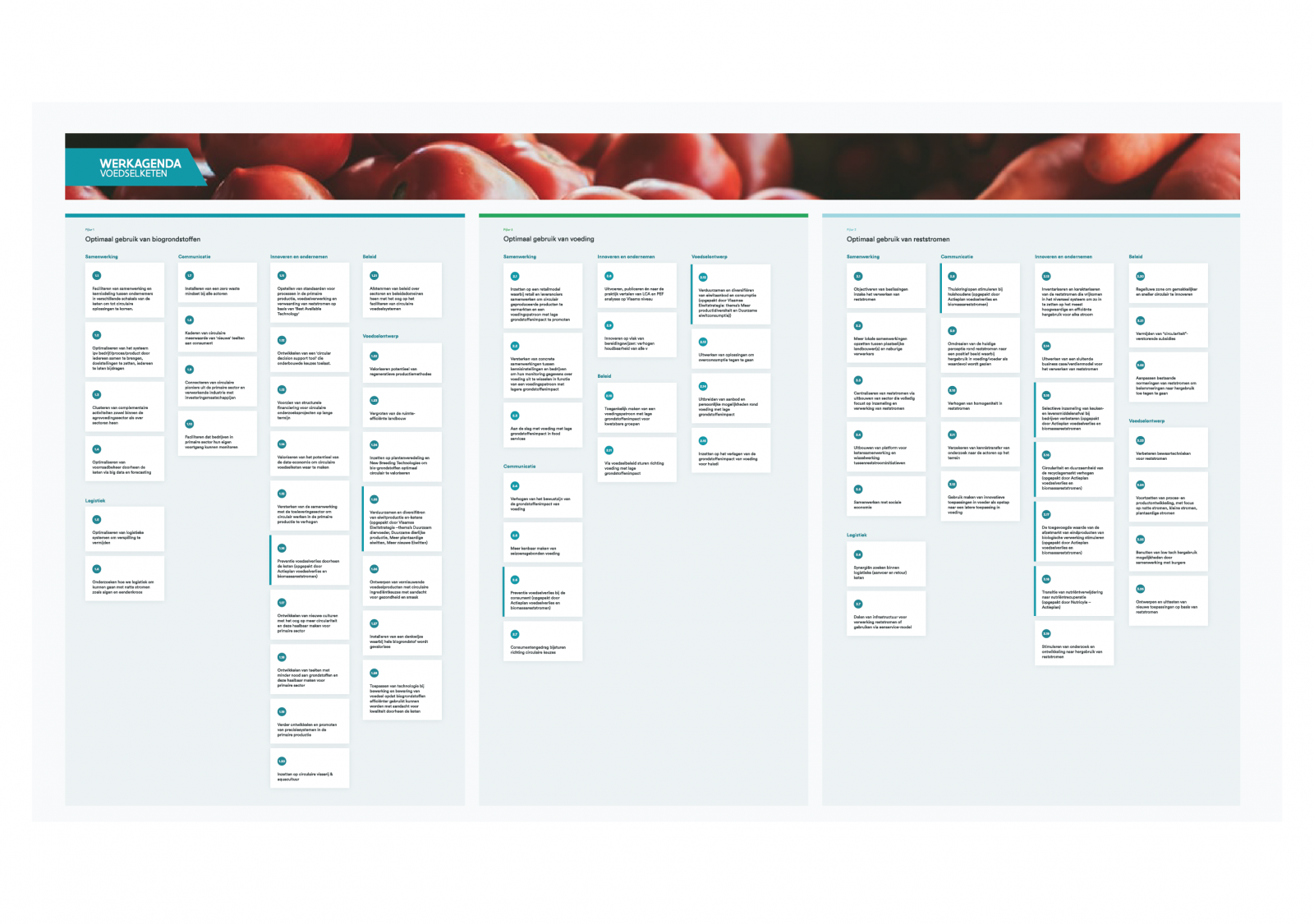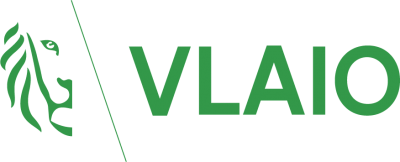Topics
We organise our actions in six thematic & strategic agendas:
Strategic Agendas:
Bio-economy
Circular Construction
Chemicals/Plastics
Manufacturing Industry
Food Chain
Water Cycles
Seven leverages provide additional support:
Leverage effects:
Lever Policy Instruments
Lever Circular Procurement
Lever Communication
Lever Innovation & Entrepreneurship
Lever Financing
Lever Jobs & Skills
Lever Research
What, why and how?
Why are we pursuing a circular economy?
Future visions 2050
How do we see our circular future?
About our management
Who steers what at Flanders Circular?
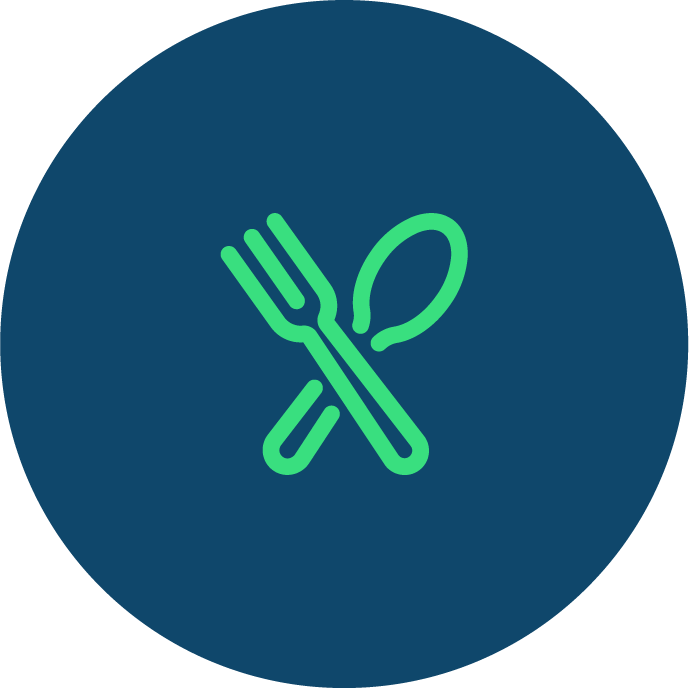
Our Approach / Strategic Agendas
Food chain
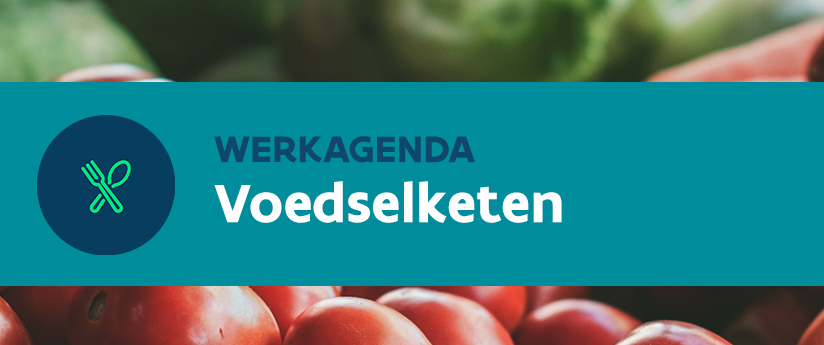
Work paths and actions
Setting up a learning network around the circular food chain
What: Within the food chain, circular economy is a term not often used. A learning network can translate this concept into concrete examples to inspire companies and organisations in the food chain and show them the added value of circularity. Within this learning network, we want to move from inspiring, to learning to doing.
Project group? Flanders' Food, Fevia, B2Be Facilitator/ILVO, Vlaio
Overview of impeding legislation
Frame within pillar 1 work path 21: Aligning policies across sectors and policy domains with a view to facilitating circular food systems
What: Listing the current legal and administrative barriers that the food chain currently encounters with circular initiatives, raising them with the relevant policy level and then addressing and trying to resolve them
Project group? Fevia, Boerenbond, BFA, VBT
Building out a physical biomass hub
Frames within pillar 3 work path 3: Centralise residual flows via building a sector that focuses entirely on collection and processing of residual flows
What: Developing a biomass hub for processing (green) fresh residue streams into valorised end products. The focus is on primary processing because that is where the greatest potential lies.
Project group? ILVO, VLAIO, Boerenbond, VBT
Other actions are still in the concept phase and will appear on this page when they are further specified.
If you are interested in learning more about these actions, please contact the programme manager of this strategic agenda Katrien Devroe, katrien.devroe@mobius.eu.
Presentation of the strategic agenda
In our strategic agenda report you will find all actions and commitments in detail.
Collaboration
- Facilitating cooperation and knowledge sharing between entrepreneurs in different links of the chain to achieve circular solutions
- Optimising the system rather than company/process/product by bringing everyone together, setting objectives, letting everyone contribute
- Clustering complementary activities both within the agri-food sector and across sectors
- Optimising inventory management throughout the chain through big data and forecasting
Logistics
- Optimise logistics systems to avoid waste
- Investigate how to logistically handle wet streams such as algae and duckweed
Communication
- Installing a zero waste mindset among all actors
- Framing circular added value of 'new' crops to consumers
- Connecting circular pioneers from the primary sector and processing industry with investment companies
- Facilitate that companies in primary sector can monitor their own progress
Innovation and entrepreneurship
- Drawing up standards for processes in primary production, food processing and valorisation of residual flows based on 'Best Available Technology'.
- Developing a 'circular decision support tool' that allows informed choices
- Providing structural funding for long-term circular research projects
- Valorise the potential of the data economy to make circular food chains a reality
- Strengthening cooperation with the supply sector to increase circularity in primary production
- Preventing food loss throughout the chain (Action plan food loss and biomass waste streams circular)
- Develop new cultures to increase circularity and make them feasible for primary sector
- Develop crops with less need for raw materials and make them feasible for the primary sector
- Further develop and promote precision systems in primary production
- Focus on circular fishery & aquaculture
Policy
- Aligning policies across sectors and policy domains with a view to facilitating circular food systems
Food design
- Valorise potential of regenerative production methods
- Increase space-efficient agriculture
- Deploy plant breeding and New Breeding Technologies to optimise the circular valorisation of bio-resources
- Making protein production and chains more sustainable and diversified (Flemish Protein Strategy: themes Sustainable Animal Feed,
- Sustainable Animal Production, More Vegetable Proteins, More New Proteins)
- Designing innovative food products with circular ingredient choices with attention to health and taste
- Installing a mindset that valorises whole bio feedstock
- Applying technology in food processing and preservation so that bio-based raw materials can be used more efficiently with attention to quality throughout the chain
Collaboration
- Commit to a retail model where retail and suppliers work together to market circularly produced products and promote low-resource impact diets
- Strengthen concrete collaborations between knowledge institutions and companies to exchange their monitoring data on nutrition as a function of a diet with lower raw material impact
- Getting started with low-resource impact nutrition in food services
Communication
- Raising awareness of the resource impact of food
- Making seasonal food more widely known
- Consumer food loss prevention (Action plan food loss and biomass waste streams circular)
- Adjusting consumer behaviour towards circular choices
Innovation and entrepreneurship
- Carrying out, publishing and translating LCA and PEF analyses into practice at Flemish level
- Innovate on preparation methods: increase shelf life of all foods
Policy
- Making a low-resource impact diet accessible to vulnerable groups
- Steering towards low-resource-impact food via food policy
Food design
- Making protein supply and consumption more sustainable and diversified (Flemish Protein Strategy: themes More product diversity and Sustainable protein consumption)
- Developing solutions to combat overconsumption
- Expanding supply and personal opportunities around low-resource impact nutrition
- Commit to reducing raw material impact of pet food
Collaboration
- Objectifying decisions on processing residual flows
- Establish more local partnerships between local farmer(s) and neighbouring processors
- Centralising residual flows via building a sector that focuses entirely on collection and processing of residual flows
- Building platform for chain cooperation and interaction between residual stream initiatives
- Collaborating with social economy
Logistics
- Seeking synergies within logistics (supply and return) chain
- Share infrastructure for processing residual flows or use through a service model
Communication
- Encourage home cycles in households (Food loss and biomass waste streams circular action plan)
- Reversing the current perception around waste streams to a positive image where reuse in food/feed is seen as valuable
- Increasing uniformity in residual streams
- Ensure knowledge transfer from research to actors in the field
- Using innovative applications in feed as a stepping stone to later application in food
Innovation and entrepreneurship
- Inventory and characterise the residual flows released in the universal system in order to target the highest quality and most efficient reuse for each flow
- Developing a conclusive business case/earnings model for processing residual flows
- Improve selective collection of kitchen and food waste from companies (Food Loss and Biomass Waste Circular Action Plan)
- Increase circularity and sustainability of the recycling market (Food Loss and Biomass Waste Streams Circular Action Plan)
- Stimulate value-added marketing of end products from organic processing (Food Loss and Biomass Waste Streams Circular Action Plan)
- Transition in nutrient use, production and recovery (Flemish Fertiliser Action Plan 2023-2026)
- Encouraging research and development into reuse of residual flows
Policy
- Regulation-free zone for easier and faster circular innovation
- Avoiding "circularity"-distorting subsidies
- Adjust existing standards of residual streams to counter barriers to reuse
Food design
- Improve storage techniques for residual streams
- Continuing process and product development, with focus on wet streams, small streams, vegetable streams
- Leveraging low tech reuse opportunities through collaboration with citizens
- Designing and testing new applications based on residual flows
Work paths: the visual
We made a visual overview of the pillars and work paths of the strategic agenda.
